Bikes on ‘L’ trains
Bicycles are permitted on all CTA ‘L’ trains most hours on weekdays (except during rush periods, from 7-9am and
4-6pm)—and all day on Saturdays, Sundays and holidays. If you board outside of rush hour restriction times and your ride extends into these hours, you’ll be allowed to finish your ride.
Important: Divvy and other bikeshare bikes are not allowed on CTA. Also, during busy periods, staff on the train or in the station may ask that you wait until trains become less crowded before boarding. We also sometimes prohibit bicycles on a line—or on the entire ‘L’ system—during periods where we expect heavy ridership, to ensure everyone’s safety. Check for alerts online or in stations before you travel.
- When entering a train station, use a wide turnstile gate that swings open if there’s one available. Otherwise, station staff can open a manual access gate to let you in once you’ve paid a fare.
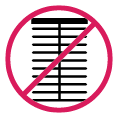 Do not attempt to carry your bicycle through tall, rotating metal barrier gates (“rotogates”): it will get caught!
Do not attempt to carry your bicycle through tall, rotating metal barrier gates (“rotogates”): it will get caught!- Note that we don’t allow people to exit at the King Drive Green Line station since it only has rotogates for outbound exiting—simply stay on until Cottage Grove if you’re wishing to reach the area.
- To reach platform level, please use elevators whenever they’re available. Otherwise, carry your bicycle on ramps and stairways and be sure to allow others to pass before you go up or down. Bicycles are not permitted on escalators.
- When a train is approaching or leaving, stay well clear of the platform edge. If a train is crowded, please wait for the next one for the safety and comfort of others.
- Before boarding, check to see if other cyclists are present—only two bicycles are allowed per railcar.
- Once on board, stand with your bike and always hold onto it. Do your best to avoid blocking aisles or doors and never leave your bike leaning/standing alone with a kickstand. Never block the aisle or doors. Do not use your bicycle kickstand inside stations or rail cars.
Tips:
When bringing a bike on the train, look for the green bicycle decal next to one of the sets of doors on as your train stops—there is typically more space for bikes at that half of the car.
Remember: Though we may sometimes need to ask that you not bring your bike on the train during crowded times, crowding restrictions don’t apply to using the racks on buses. We encourage you to know your alternatives in the event of crowding and consider the bus system as your backup plan if ever you can’t fit safely on trains.
Stand with your bike in either end of the railcar or, if not in use, you can flip up the seat in a railcar’s wheelchair area(s) to make sure other people can stand or move around the car comfortably. Just be sure to yield this space if it’s needed by a rider with a disability or someone who needs priority seating.
In an emergency
In the event of an emergency evacuation, leave your bicycle behind to ensure a swift and safe exit for everyone. If you can do so quickly and safely, put your bicycle on top of or between seats to keep aisles and emergency paths between railcars clear.
Bikes on buses
All CTA buses are equipped with a bike rack on the front of the bus, which has a special lever arm that goes over your front wheel to hold your bike in place while the bus is in motion.
- Remove bags or other hanging items from your bike, including panniers, before the bus arrives. (You’ll need to bring your bags or any other items that might come loose with you onto the bus.)
- Alert the bus operator that you’ll be loading your bicycle. If you’re the first person to load a bike onto the bus, you’ll need lower the rack by squeezing the center handle.
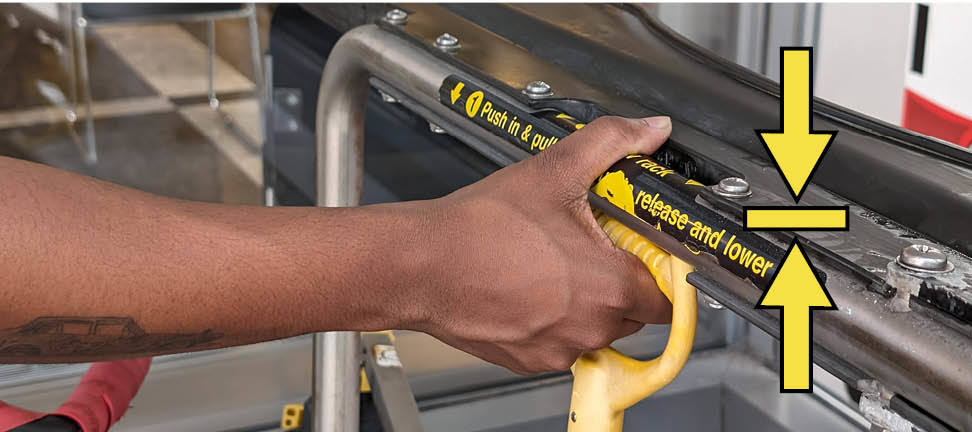
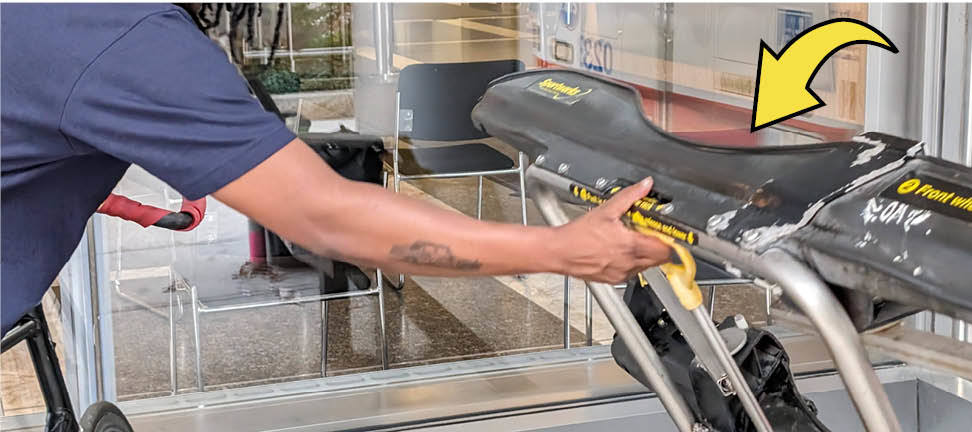
- Lift your bicycle so it sits in the empty wheel well closest to the face of the bus. If yours is the first to be loaded, do so with your front wheel facing the curb since this is where the support arm is. (If yours is the second, your front wheel should face away from the curb).
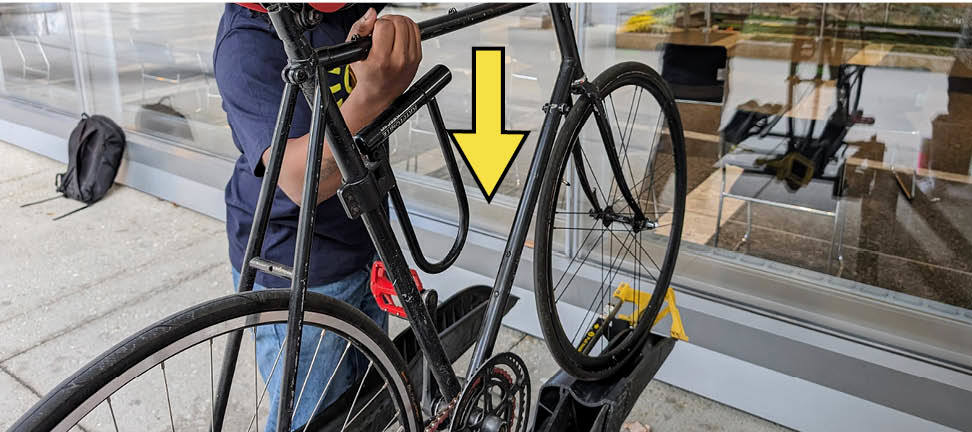
- Pull the spring-loaded support arm out and then upwards, to pull it completely over the top of your front wheel and nestle it where the wheel meets the wheel fork to help hold your bike in place. If you’re concerned about the safety of your bicycle, you can lock your front wheel to your bicycle frame—but do not lock your wheel or bike to the bus rack.
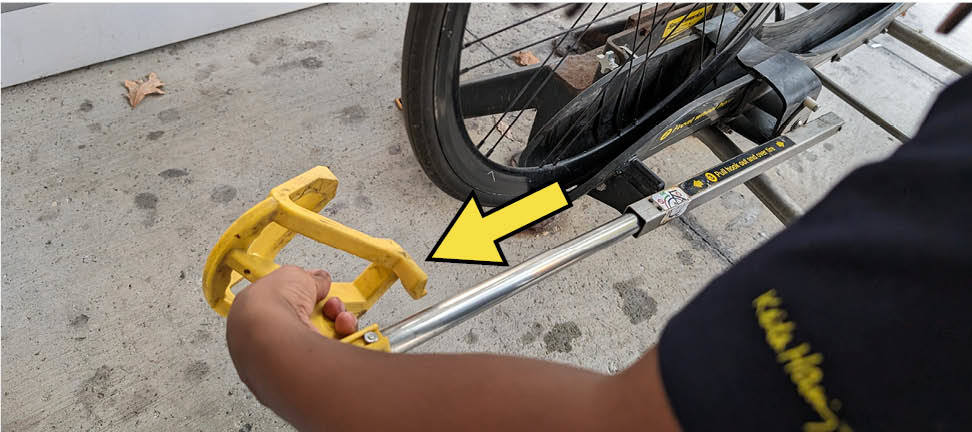
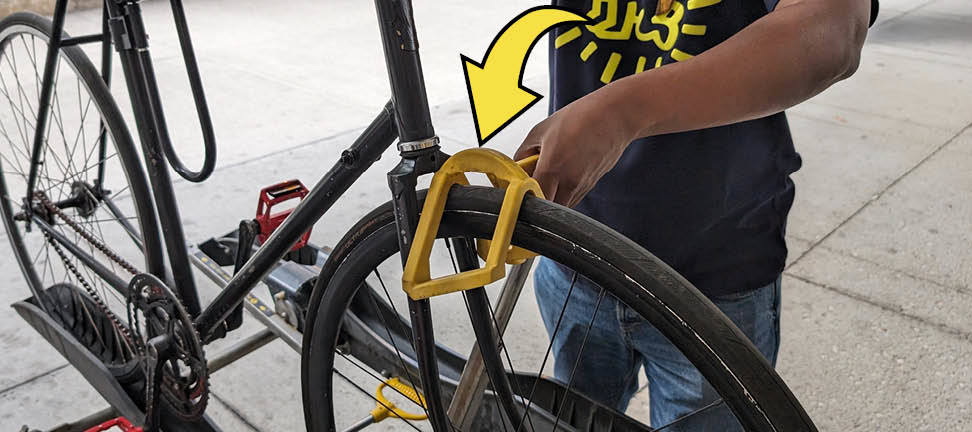
- Board and pay your fare. We recommend that you sit or stand near the front of the bus to keep an eye on your bike while riding.
- When you come to your stop, exit the bus at the front and be sure to tell the driver that you’re removing a bicycle.
- To remove your bike, lift and stow the support arm back in its down position and lift your bike off the bus. If there are no other bikes in the rack, squeeze the handle and lift the rack back into its upright position.
Forgot your bike on a bus?
We hope it never happens to you, but this happens sometimes! If someone leaves a bike, it’ll likely end up back at the garage that the bus came from and stored in the garage’s Lost & Found. Check our Lost & Found page online to figure out what garage your bus route comes out of and call the next day to see if they have your bike.
Note some routes have their buses come from multiple garages. (This is also true of train lines, and the procedure is the same.)
General information
Things you should know
- Riders who are 14 years old or older may bring a bicycle on a train or bus; 12- or 13-year-olds must be with an adult. Children under 12 may not bring bicycles on CTA.
- Many CTA rail stations have indoor bike parking and almost all have racks outside or close by.
- Cyclists assume all responsibility for any damage and/or injury that occurs as a result of their bicycle being on CTA property. This includes injury to the cyclist or others. A sudden stop or other incident does not remove responsibility from the bicycle owner for damages or injuries, so always be with your bike and in control, holding it in place and be prepared for the potential of a sudden stop.
- Folding bicycles are allowed inside buses and trains at all times.
- Fuel-/gas-powered bicycles of every kind are prohibited on the CTA.
- Divvy and other public bikeshare bikes and scooters are not permitted on CTA buses or trains (or in the fare-paid areas of CTA stations).
- Never, ever ride your bike or other micromobility device in an ‘L’ station. Any mistake can lead to you injuring another person or ending up on the tracks--possibly injured and unable to get back up! Trains enter stations faster than you think and the rails are always electrified!
Scooters, bikeshare & more
- Divvy bikes, e-bikes are available through much of Chicago and Evanston as an option for when you don’t have or want to bring your own bike and connect well with much of our system. Learn more at divvybikes.com.
- Additional micromobility options exist that can help connect you with our services, including e-scooters through Divvy and other providers who offer similar options
- Personal e-bikes and scooters are welcome on CTA, but you may not bring commercially-owned (bikeshare/scooter-share) bikes or scooters on our system. This includes Divvy bikes, which may not be brought on CTA buses or trains. Note that bus bicycle racks are designed to be sturdy, but may not be able to accommodate heavy or bulky e-bikes safely. Follow driver advice.
- Personal e-scooters must be folded during rush periods or when buses or trains are crowded.
- Folding scooters and bikes, including e-bikes, are always allowed on the ‘L’ and buses, if folded.
- Bikes and scooters you’re allowed to bring with you must not be dirty or greasy to a point where they soil seats, railcar interiors or equipment, or create a nuisance or hazard to other riders.
- Bikes on CTA must be less than 72 in (182 cm) long and no more than 30 in (76 cm) wide.
Tips & help
Bicycle racks at CTA ‘L’ stations
Bicycle parking racks are installed outside most ‘L’ stations to make it easy to bike to the train. Many stations also have sheltered outdoor or even indoor bike parking, for added security and weather protection.
Trip ideas
Bike & ride isn’t just for regular trips or commutes—it’s a great option for healthy, weekend adventures! Here are a few popular destinations and trails CTA can take you to:
- Chicago’s Lakefront Trail: Access by most ‘L’ lines and get near with numerous east-west bus routes.
- Illinois Prairie Path: Take Blue Line to Forest Park and follow path from north side of station to 1st Avenue where trail begins.
- North Shore Channel Trail: A short ride from Rockwell on the Brown Line or Noyes on the Purple Line.
- North Branch Trail: A short ride from Francisco or Kedzie on the Brown Line (sections before Foster may require some street riding).
- Skokie Valley/Sauganash trail: Runs alongside the Yellow Line from either the Oakton-Skokie or Dempster-Skokie stations.
- Bloomingdale Trail: Blue Line to Western or Damen (access points at Western, Milwaukee or Damen Aves).
- The Boulevard System: Nearest ‘L’ access: Blue Line at Logan Square or from Pulaski (for Independence Blvd, 2 blocks east), Green Line at Conservatory/Central Park Drive or Garfield, Pink Line from Kedzie or California (for Marshall Blvd, between the two), Orange Line at Western or from 35th/Archer (for Western Blvd) or Red Line at Garfield.
- Calumet Park & The Burnham Greenway: Via Red Line to 69th and #30 bus to 95th to Calumet Park and Burnham Greenway south.